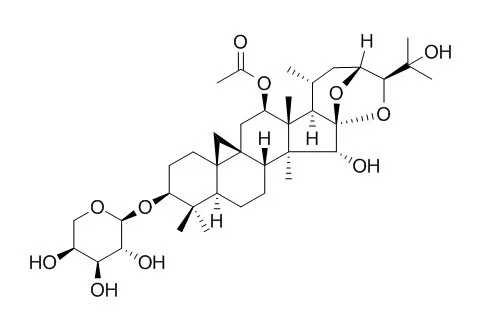| Structure Identification: |
| Planta Med. 2010 Mar;76(5):467-73. | | Development of a fast and convenient method for the isolation of triterpene saponins from Actaea racemosa by high-speed countercurrent chromatography coupled with evaporative light scattering detection.[Pubmed: 19847744 ] |
In the present work, a fast and simple method for the separation and purification of triterpene saponins from Actaea racemosa was successfully established.
METHODS AND RESULTS:
Accelerated solvent extraction was used for defatting and extracting of the subaerial parts, giving a triterpene enriched crude extract. Size exclusion chromatography was used to separate actein and 23-epi-26-deoxyactein from other triterpenoids, which were collected in a third fraction. This most complex third fraction was applied to high-speed countercurrent chromatography, a well-established technique for the separation of saponins. Separation parameters were first optimized on an analytical level, using a hyphenated HSCCC-ELSD setup, before the system was scaled up to preparative size. The resulting two-phase solvent system, consisting of N-hexane-acetone-ethyl acetate-2-propanol-ethanol-water (3.5 : 1 : 2 : 1 : 0.5 : 2, v/v/v/v/v/v), enabled the isolation of 23-O-acetylshengmanol-3-O- beta-D-xylopyranoside (17.4 mg), Cimiracemoside D (19.5 mg), 25-O-acetylcimigenol-3-O-beta-D-xylopyranoside (7.1 mg) and the aglycone cimigenol (5.9 mg). Purity of the isolated substances was 96.8 %, 96.2 %, 97.9 %, and 98.4 %, respectively.
CONCLUSIONS:
The same method was suitable for the purification of actein and 23-epi-26-deoxyactein, with purities of 97.0 % and 98.3 %.
|
|






 Cell. 2018 Jan 11;172(1-2):249-261.e12. doi: 10.1016/j.cell.2017.12.019.IF=36.216(2019)
Cell. 2018 Jan 11;172(1-2):249-261.e12. doi: 10.1016/j.cell.2017.12.019.IF=36.216(2019) Cell Metab. 2020 Mar 3;31(3):534-548.e5. doi: 10.1016/j.cmet.2020.01.002.IF=22.415(2019)
Cell Metab. 2020 Mar 3;31(3):534-548.e5. doi: 10.1016/j.cmet.2020.01.002.IF=22.415(2019) Mol Cell. 2017 Nov 16;68(4):673-685.e6. doi: 10.1016/j.molcel.2017.10.022.IF=14.548(2019)
Mol Cell. 2017 Nov 16;68(4):673-685.e6. doi: 10.1016/j.molcel.2017.10.022.IF=14.548(2019)